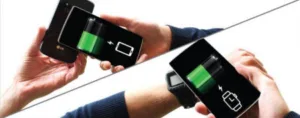A team within the Bristol Interaction Group at the University of Bristol (Bristol, UK) led by Paul Worgan is developing a novel means to address the issue of limited battery life in mobile devices. The starting point of the team’s approach is considering power as a commodity that can be shared between mobile devices in an opportunistic, on-the-go basis.

Called PowerShake, the new technology enables users to balance intra-personal power levels amongst their own devices and to trade power intra-personally, between themselves and others. The process is illustrated in the figure below.

The most recent results from the team were presented at the 2016 Conference for Human-Computer Interaction held during early May in San Jose, CA. The team’s presentation is captured in an article entitled “PowerShake: Power Transfer Interactions for Mobile Devices.” A copy of the article can be found here.
Some features of PowerShake’s Wireless Power Transfer technology and the prototype fabricated to demonstrate the technology are as follows.
- With 3.1W available, a transfer and can support “ongoing/continuous tasks.” In a typical smartphone, this means that about twelve seconds of charging will enable about 1 minute of additional talk time. Two minutes of charging can support about 4 minutes of video.
- Fits in a small form factor. The use of flexible coils allows integration into wearables, watch bands and the like. The thickness is less than 1.5 mm.
- The system is compliant with electromagnetic safety guidelines – even with continuous use in close proximity to the body.
A video illustrating the PowerShake system can be found at the end of this article.
The wireless power transfer approach used in PowerShake is based on inductive charging and implemented through the use of electromagnetic resonant coils. Both the transmitter and the receiver contain a coil and a bandpass filter designed to finely tune the system circuits to a specific frequency. This allows power to be efficiently transferred when the coils are close together. The figure below illustrates the transmitting and receiving coils in the prototype.
The efficiency of power transmission drops quickly as the distance between the coils increases. Misalignment between the transmitter and receiving coils also has a very negative effect on the efficiency. The specific design of the PowerShake approach is reported to actually be quite good with respect to misalignment in that a misalignment of 8 mm still allows for a power transmission efficient of about 86%. To assure that the power transmission efficiency remains this high, the PowerShake team included a “docking mechanism” into the mechanical design of their system that serves to optimally position the coils during power transfer.
The article cited above also reports on a series of workshops conducted by the team to explore both the hardware and use case aspects of their technology. Included in these discussions were the topics of “how PowerShake can be included in real devices, the way power interactions could be conducted, scenarios where they could be applied and social implications enabled by the change of perspective that PowerShake enables, transforming power from a personal resource, to a social tradable commodity.”
PowerShake technology necessarily adds weight, size and cost to mobile devices. These penalties could, however, be engineered to be quite modest. If the benefits of this approach to power management turn out to be both achievable and significant, then PowerShake may have a commercial future. – Arthur Berman
Bristol Interaction Group, Paul Worgan, +44 (0)117 331 5663, [email protected]

